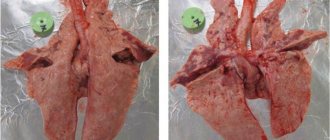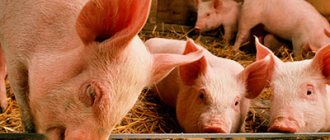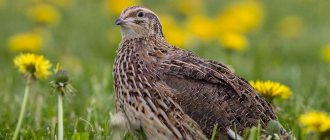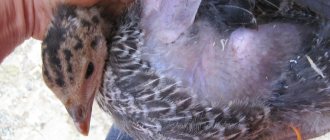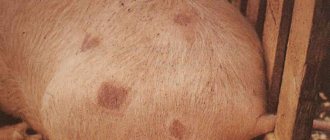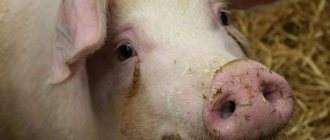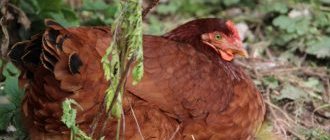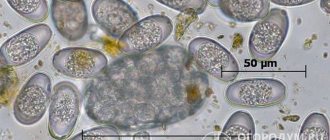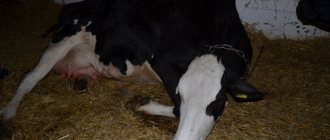Disease prevention
To date, there is no vaccine against bird flu, although scientists around the world are working on its creation. To avoid infection, doctors recommend following simple preventive measures:
- The very first preventive procedure is vaccination against “classical” types of influenza. It can be performed at any clinic in the city. The vaccination is aimed at strengthening the immune system. The vaccine contains active components that stimulate the production of protective antibodies against regular influenza, and its virus has several antigens similar to the H5N1 virus;
- Poultry meat and eggs may only be purchased in known places where they are inspected by the sanitary service;
- If you are engaged in agricultural activities and keep birds, then you must monitor their health. The unexpected death of several individuals may indicate infection. Under no circumstances should you touch them without gloves. After destroying sick individuals, hands and clothes should be treated;
- If there has been contact with a bird and a person has any signs of bird flu, then you should immediately contact a medical facility;
- During seasonal influenza epidemics, the population should spend more time in the fresh air, get proper rest, ventilate the living areas of the apartment and carry out wet cleaning.
WHO recommendations for personal protection
Since avian influenza is dangerous for humans, the World Health Organization has developed recommendations on how to behave to avoid infection:
- Avoid contact with wild birds and poultry showing signs of illness.
- Do not touch dead birds.
- The carcasses of sick birds should be burned, protecting the hands and respiratory tract with special protective equipment.
- Do not eat meat and eggs that have undergone insufficient heat treatment.
- Store eggs and chicken meat away from other foods in the refrigerator.
- If you discover the body of a dead bird, you should immediately notify your local veterinary service.
- Before use, wash egg shells with soap.
- After cutting the carcass, wash the cutting board and hands with soap.
- Do not purchase eggs and chicken carcasses from dubious sources.
Bird flu is a dangerous viral disease that cannot be treated in birds.
Important! If, after contact with a bird, a person develops symptoms of influenza or ARVI, it is necessary to immediately consult a physician.
Infection can only be avoided by observing sanitary and hygienic standards, quarantine measures and carefully selecting livestock for purchase.
Actions upon detection of illness
The appearance of any alarming symptoms is a good reason to contact a veterinarian. After conducting a series of studies, he will be able to accurately diagnose the diagnosis.
Before the doctor arrives, each owner must take special precautions:
- Isolate sick individuals.
- To be temporarily removed from the slaughter and sale of chickens.
- Do not transport anything from the farm. All equipment, food and animals must remain in their places.
It is rarely possible to avoid death, so the corpses should be packed in plastic bags. The veterinarian must first take a tissue sample for examination. Until the diagnosis is confirmed, it is necessary to organize quarantine. This is usually done by government agencies. For this purpose, special events are held:
- quarantine is observed at a distance of 5 km from a possible source of infection;
- the infected are isolated;
- open walking is prohibited;
- Only veterinarians and special employees are allowed to visit the suspected outbreak;
- disinfect equipment and clothing.
Forms of avian influenza in chickens
Scientists and veterinarians divide the virus into three main types:
- A – carried by waterfowl and dangerous to humans. There are more than a dozen varieties.
- B - not so dangerous, characterized by slow progression and mutation, causing the least outbreaks of infection.
- C is dangerous both for people (but you can only get it once) and for animals. Can cause severe complications and provoke local outbreaks. Doesn't mutate.
Regardless of the form of chicken flu, it may not take much time to infect an entire flock - only 48 hours, and some strains (for example, H5N1) act even faster.
Can you get bird flu?
The influenza A subtype, which causes diseases in birds, is also dangerous for humans. Infection occurs through direct contact with birds carrying this virus, their feces or objects that they constantly touch.
It is known that the virus is killed by high temperature. Therefore, when poultry meat is heat-treated for more than an hour, it is not dangerous to eat it. Eggs with blood in them cannot be eaten. Eggs that have not changed color should be boiled for at least ten minutes. Before doing this, they should be washed to get rid of infection from the shell. Eating raw eggs is very dangerous.
Danger for chickens and safety for humans
There are infectious diseases that are not harmful to humans. Let's look at them below.
Reduced egg production syndrome-76
SSY-76 is a viral disease. The disease affects the genitals of laying hens. Due to the disease, not only egg production decreases, but also the shape of the eggs and their quality change, the shell becomes soft or completely absent.
The disease has no characteristic symptoms. Some poultry farmers note that chickens have ruffled plumage, prostration, and diarrhea. In the later stages of the disease, the comb and wattles may turn blue, but this does not affect all birds. Within 20 days, chickens lay deformed eggs, and egg production decreases by 30%. Cage housing of chickens can restore productivity. There is no treatment for the disease. For prevention, laying hens are vaccinated at the age of 5 months.
Eimeriosis (coccidiosis)
It is a parasitic infection caused by protozoan microorganisms. Small birds that are no more than 2-8 weeks old are most susceptible to the disease. Therefore, it is not surprising when two-month-old chickens begin to die. The incubation period lasts 3-5 days.
Birds experience an acute course of the disease, manifested by the following symptoms: thirst, depression, a sharp decrease in appetite with refusal to feed. Chicks often huddle together in an attempt to stay warm, with their wings drooping and feathers ruffled. After clinical signs, the bird dies within 2-4 days.
At the first signs of the disease, all livestock are treated with coccidiostats, which are divided into two groups: preventing the development of immunity to eimeriosis; allowing the development of immunity. Often, infection with the disease occurs through water and food contaminated with oocytes. For prevention, veterinary and hygienic rules for keeping chickens are observed. Bird droppings should not be allowed to get into the water or feed. Animals must be kept in cages that can be easily disinfected.
Newcastle disease
A virus that is quite stable in the external environment, and is also capable of penetrating a chicken egg in utero and surviving in the egg during the incubation period. Therefore, already sick chickens may be born.
The disease has three types of disease course, as well as a typical and atypical form. In the hyperacute course of the disease, the entire chicken coop is affected within a few days. The virus causes damage to the nervous system of birds, so the disease is accompanied by difficulty breathing, severe excitability, and paralysis of the limbs. This leads to the birds having a twisted neck and poor coordination of movements.
Nervous signs of Newcastle disease
With Newcastle disease, the bird's neck bends and coordination is impaired.
There is semi-paralysis of the neck, wings, legs
In the typical form of the acute course of the disease, chickens often suffer from diarrhea or die from suffocation. The atypical form of the disease often occurs without characteristic clinical signs, affecting mainly young chickens. The main preventive measure is compliance with sanitary standards.
Leukemia
A disease caused by oncoviruses and often knocks down chickens that are older than 16 weeks. The disease is accompanied by decreased egg production, exhaustion, anemic scallops, and diarrhea. Chickens can develop tumors, often in the chest, in and under the skin.
The disease has no cure. Suspicious chickens are isolated or sent to slaughter. For preventive measures, it is recommended to take young animals and hatching eggs from leukemia-free farms.
Marek's disease
The disease is called neuritis, infectious neurogranulomatosis, and avian paralysis. The causative agent of a viral disease is one of the forms of herpes. The virus is stable in the external environment, but is extremely sensitive to common disinfectants: chlorine, phenol, formaldehyde, alkalis, Lysol. The incubation period of the disease can last about 5 months.
In the acute form of the disease, chickens are exhausted, apathetic, and their egg production decreases. Birds suffer from abnormal position of the body, head, and limbs. In 46% of cases, sick birds die.
The main preventive measure is vaccination of chicken livestock with “live” vaccines. A vaccine is used from strains of the virus of this disease and strains of the turkey herpes virus. Also, as a preventive measure, eggs during the incubation period are imported only from farms that have positive recommendations.
It is important to strictly observe hygiene rules in poultry houses
Paw paralysis due to Marek's disease
Causes of non-infectious diseases of broilers and their elimination
The causes of non-infectious diseases in broilers are usually non-compliance with temperature conditions or feeding regime and diet.
Enteritis may be a sign of an infectious disease. Other diseases: gastritis, dyspepsia, cuticulitis, are usually a consequence of an unbalanced diet or feeding with low-quality feed. Eliminating the causes of these diseases is simple; it is enough to switch the chickens to high-quality factory feed to prevent contamination of homemade feed with pathogenic microorganisms. Factory feed should also be stored in a cool, dry place.
Bronchopneumonia is a consequence of hypothermia in chickens when a secondary infection enters the respiratory tract. Treated with antibiotics.
Important! If you are sure that the chicken has only frozen, but has not yet become infected with pathogenic microorganisms, it is enough to place it in a warm place.
Signs of hypothermia: foamy discharge from the eyes and nasal openings of the beak. In addition, such a chicken trembles all over. A simple cold goes away in a couple of days in a box with an air temperature of about 40 degrees.
Frozen chickens squeak and try to huddle together. In this case, the room temperature needs to be increased.
When overheated, chickens try to move as far as possible from the heat source. Sedentary. They often lie with their beaks buried on the floor. The temperature is reduced.
Despite the number of diseases detrimental to an individual, chicken as a species is not going to give way to any other poultry. And in fact, if the necessary sanitary standards are observed, chicken diseases are not as terrible as they might seem. Although you have to be prepared for the loss of your entire chicken population.
Prevention measures
The Ortomyxoviridae virus is very insidious and at the same time deadly. He can get close to people and residents of his personal plot quickly and unnoticed. However, you should not immediately panic. There are many ways to protect chickens from this disease, and therefore not lose the livestock completely or even partially.
Among the key preventive measures, experts highlight the following:
- during periods when there is an outbreak of chicken flu or there is at least a slight suspicion of its appearance in the surrounding area, chickens should be protected from contact with wild and even neighboring birds as quickly as possible;
- you should not allow chickens to be in places where there were any wild birds, even for a short time;
- do not feed chickens with duck and chicken eggs purchased on the market and the quality of which has not been confirmed by laboratory tests;
- It is mandatory to introduce the maximum amount of vitamin and mineral supplements into the chickens’ diet, with the help of which it will be possible to strengthen their immune system;
- for preventive purposes, periodically give the birds to drink medications that are usually used in the treatment of sinusitis.
Bird flu is a relatively new disease and not yet fully understood. No matter how hard scientists try, they have never been able to develop a vaccine against it. Accordingly, if the livestock is affected by this virus, there is only one way out - the birds are sent for slaughter. Moreover, the poultry farmer will have to part with not only infected individuals, but also those who simply came into contact with them.
Forecast and prevention of bird flu
A vaccine against the virus is being actively developed. Research is being conducted in many Russian, American and Chinese laboratories.
Today the forecast for bird flu is disappointing. When infected with an acute form of the disease, the livestock dies in 99% of cases. In addition, there is a risk of influenza transmission to humans.
To prevent an outbreak of infection, the following measures are taken:
- Repellers, traps and other devices are installed around the poultry house area to help repel wild animals, small rodents and other animals. They can be potential carriers of diseases.
- The poultry house is disinfected daily using chemicals, for example, soda with chloramine.
- Bird perches and nests are treated with slaked lime.
- Breeders take antiviral medications for preventive purposes.
Prevention measures:
- Keep children away from game or infected birds.
- Do not handle dead or sick chickens.
- If you find the remains of a dead bird, do not approach it yourself and do not allow anyone to approach the place of death. If possible, the corpse should be destroyed by fire, protecting the mouth and nose with protective equipment, and the hands with gloves. At the end of work, you need to wash your hands, face and change clothes.
- You should not eat raw foods, including undercooked meat and undercooked eggs.
- If you notice symptoms of the virus in your house, call your veterinarian.
- If you suspect influenza infection after being around birds, seek medical attention.
Stages of avian influenza disease
A viral infection, entering the chicken body, multiplies on its mucous membranes. Within 4 hours, the strain infects the blood, adversely affecting its formula, causing a deficiency of red blood cells.
During the entire period of stay in the body of any living creature, the influenza virus goes through 4 stages of development:
- It is characterized by the proliferation of infection and the accumulation of toxic substances in the body.
- The virus already enters the blood and is easily detected in its composition. This is the period of viremia, when there is a massive mortality of the chicken population. It occurs due to the release of toxins.
- The reproduction of viruses has already stopped, and the body produces antibodies.
- An accumulation of antibodies occurs in the body of a sick bird, which triggers a mechanism of resistance to the disease.
Not only infectious diseases can cause chickens to feel unwell; find out how to deal with worms, ticks, lice, fleas, and feather eaters.
Stages of the disease
After the AI virus enters the bird's body, the pathogens multiply rapidly. The period between stages 1 and 2 is short - 4–5 hours, during which time pathogens enter the bloodstream.
Examination of chickens by a veterinarian
The virus causes the breakdown of red blood cells and spreads to internal organs. At the third stage of the disease, the body reacts by producing antibodies. The final stage is recovery, after which immunity to the disease is formed.
Attention! If the bird's immune system cannot cope with the infection, death from intoxication occurs.
Main forms of bird flu
Modern veterinary science classifies influenza as RNA viruses of the genus Orthomyxoviridae, which, according to serological characteristics, include 3 serotypes:
- A - its carriers are wild waterfowl. Outbreaks of this infection often cause pandemics among humans and deaths in poultry. The serotype is considered the most virulent and pathogenic for humans and can lead to serious complications. Varieties of influenza A are divided into several strains (H1N1, H2N2, H3N2, H5N1, H7N7, H1N2, H9N2, H7N2, H7N3, H7N5, H10N7 and others);
- B - serotype is less common compared to the previous one. It mutates 2-3 times slower and is characterized by genetic diversity. It is characteristic that its mutations lead to changes in circulating strains every 3-5 years, which is the cause of the corresponding epidemics. Note that the insignificant mutagenic potential and the limited number of virus carriers lead to the fact that the influenza B pandemic has not been recorded in nature;
- C - viruses of this serotype infect people and animals, and also provoke severe complications and local outbreaks. The absence of mutations in this form of influenza means that a person gets sick with it only once in his life, and subsequently develops lasting immunity.
Important! In humans, the symptoms of bird flu are no different from those of other viral infections, but the mortality rate is much higher. Patients experience: headaches and muscle pain, general weakness, fever, nausea, vomiting, diarrhea, bleeding from the nose and gums.
On the 5th day of the disease, breathing problems begin.
Today, scientists know about 15 subtypes of type A viruses. The most dangerous of them are considered to be H5N1 and H7N7. Simultaneous circulation of several strains of influenza is possible. It takes a very short time for the infection to affect the chicken body. After just 48 hours of disease development, the entire livestock can be lost. Pupil damage may be a symptom of bird flu
There are cases when the disease is asymptomatic and mild. Then, in domestic birds, the dynamics of egg laying may decrease and the external characteristics of the feathers may deteriorate. But severe forms of influenza appear within 20 hours after the infection enters the bird’s body. The duration of the incubation period can be from 3 to 5 days.
The course of bird flu can be characterized by the following forms:
- acute (the most dangerous with a bright clinic);
- subacute (the disease lasts from 10 to 25 days and is characterized by an unlikely mass mortality of livestock, recovery occurs in approximately 80 percent of cases);
- chronic (occurs when infection occurs with a low-pathogenic strain and is asymptomatic).
Find out why growths occur on the legs of chickens, why chickens go bald and how to treat them, why chickens diarrhea.
Treatment of bird flu
The use of modern diagnostic methods in combination with properly selected therapy gives a positive result that affects the patient’s well-being.
The diagnosis can be established only after a conversation with a doctor, a thorough examination of the patient and evaluation of the results of laboratory tests. The treatment strategy for a particular patient is determined only after a clear determination of the degree of damage to organs and systems.
Treatment of children and adults is no different. Once the diagnosis is made, the patient is placed in an isolation ward. He is provided with personal utensils, clothing, hygiene products and bedding.
When in contact with such patients, personnel should use personal protective equipment in the form of a gown, gloves and gauze bandage.
Neuraminidase inhibitors are the most commonly used drugs to treat viral infections. The duration of the course of treatment and dosage are selected individually by a specialist.
The effectiveness of these drugs in treating influenza has been proven in randomized studies.
When the temperature rises above 38.5 degrees, it is necessary to use antipyretics. For example, drugs based on paracetamol or propionic acid derivatives.
During the period of weakening of the body's defenses, medications containing interferons will help strengthen the immune system.
It is important to understand that treatment for influenza is much more extensive, and drugs and their dosages are selected with particular precision. Multiple organ failure provokes a deterioration in the excretion of drug metabolites by the kidneys and their transformation by the liver, therefore only clinicians should treat such patients
Multiple organ failure provokes a deterioration in the excretion of drug metabolites by the kidneys and their transformation by the liver, so only clinicians should treat such patients.
Salmonellosis
A chicken disease such as Salmonellosis is also dangerous for human life. Young animals from a month to 50 days old carry it in a latent form, which gives Salmonella the opportunity to develop and cause an epidemic.
Symptoms of this disease in chickens:
- Lethargy, immobility, growth disturbances.
- The head is thrown back or down.
- Bloody diarrhea.
- Baldness.
- Trembling in limbs.
- Anxiety.
Bacteria attack all internal organs, leading to death. Treatment is carried out in 2 stages:
- Actually destroying bacteria.
- Restoration of microflora.
At the first stage, Levomycetin, Albak, Kolimycin are used. The drugs are mixed with water and given to young animals, limiting their food intake. The course of probiotics lasts 14 days; Bifinorm and Colobacterin are suitable for individuals. Be sure to take tests after antibiotics; if pathogens are still detected, the treatment is repeated.
Young animals aged from one month to 50 days suffer from latent salmonellosis
Treatment and control of spread
Bird flu is a highly pathogenic virus. Treatment of infected livestock is not carried out. If infected, all chickens on the farm must be destroyed to prevent the spread of infection.
- systematic monitoring of poultry stock: general condition, appetite, appearance;
- avoiding contact between chickens and wild waterfowl;
- keeping young animals separate from adult livestock;
- vaccination of poultry in accordance with the epizootic situation in the area;
- ensure that chickens are kept in a clean, dry, disinfected room during the first days of life;
- At the first suspicion of an infectious disease, separate the sick individual and contact veterinary specialists.
Lack of cleanliness and unbalanced nutrition often lead to diseases in poultry.
Symptoms of avian influenza in domestic chickens, chickens and broilers
Histomoniasis in turkey poults: symptoms and treatment
The carrier of the disease is wild waterfowl. But classical plague does not cause epidemics in wild birds. They are not as susceptible to infection as domestic birds. Therefore, infected birds show virtually no symptoms of the disease. But in poultry the disease is severe and in most cases leads to their death.
If bird flu appears on the farm, symptoms in chickens will appear quickly and acutely:
- Deterioration of the condition of young animals. Typically, young birds and chickens are less resistant to the avian influenza virus. At the very beginning of infection, their plumage will look worse, their appetite will decrease, and lethargy will appear.
- A sharp decrease in poultry productivity . Egg production decreases at the very early stage of the disease. This may indicate a mild illness that does not require human intervention. However, this symptom is also characteristic of a severe form, leading to 100% death of birds. It is almost impossible to determine whether bird flu will be mild or severe.
- Damage to the gastrointestinal tract . This will manifest itself in loss of appetite, diarrhea, and a sharp increase in temperature. Chickens will feel thirstier and drink constantly.
- Damage to the respiratory system. The manifestation of such a symptom indicates a severe form of infection, leading to mass mortality of birds. The chickens' breathing becomes difficult, and the lungs swell.
- Unusual behavior. Due to damage to the nervous system, convulsions and unnatural neck movements begin. The chicken cannot move and becomes apathetic. Multiple hemorrhages may appear. After this, within 24 hours she begins to cerebral edema.
- Blackening of earrings and comb. He speaks of a severe form, in which therapy is no longer useful, and such individuals must be urgently killed. Otherwise, they will become a source of infection for the entire livestock.
Preventive measures
What to do if the virus is insidious, invisible and at any moment can be so close to your pets that it creates a real threat of infection for them?
First of all, don't panic. Panic is the “best” way to get sick, this has already been proven by the negative experiences of many. Neither you nor your chickens need to repeat this experience.
You need something else - to prevent disease.
To do this, during an outbreak of influenza or even the slightest suspicion of its occurrence, protect your chickens from contact with wild birds, do not allow them to places where wild birds could have been in the recent past (several days, weeks, months).
Do not feed the young animals eggs from other people’s chickens and ducks (bought at the market), enrich the chicken diet with vitamins, try feeding them for a few days with the drugs you use to treat chickens for sinusitis.
What to do with a sick chicken
Avian influenza viruses are prone to rapid mutation. Therefore, it is completely impossible to invent a standard single vaccine against them at this stage of medical development. Therefore, at the first signs of an acute disease, it is necessary to urgently eliminate sick chickens.
And the rest of the chicken coop population is subject to quarantine. This suggests that:
- Affected parts of dead chicken carcasses should be sent to the laboratory for further examination. This point is very important and cannot be neglected.
- Birds that have been in contact with sick individuals also need to be exterminated. This is necessary to prevent the spread of infection.
Treatment and prevention
Treatment of most infectious diseases of chickens and chickens, even if it gives positive results, but the birds still remain for a long time (or forever) a carrier of their pathogens and are capable of infecting other inhabitants of the poultry house. Therefore, experts recommend immediately slaughtering sick birds.
From the first days of life, it is recommended to feed chickens with medications containing antibiotics, as well as universal vaccination of young animals.
In case of parasite infestation, it is recommended to treat the chicks' plumage with appropriate preparations and sand-ash baths. It is recommended to treat chickens with appropriate medications for worms.
All diseases caused by improper maintenance or feeding can be eliminated by creating appropriate conditions for young animals for a comfortable life.
The room where the chicks are kept should be much warmer than in the main house - the air temperature there should be maintained at 22-24 degrees Celsius. A colder room can cause hypothermia in young animals, which will lead to illness in broiler and laying chickens.
And we should not forget that the poultry house and the surrounding area must be kept clean, the premises and walking areas must be disinfected at least twice a year, and normal ventilation in the chicken coop must be ensured.
We must remember that the chicken coop should always be dry and clean, then the birds living in it will be healthy.
Subscribe to site updates. You'll be among the first to know the latest chicken news!
Good luck to everyone and see you again!
See modern products for poultry and livestock farmers that improve the health of pets and make our work easier.
Signs of bird flu in chickens
There are 2 main forms of bird flu.
Light
It is almost asymptomatic and goes away quite quickly, without requiring any intervention. At the same time, the egg production of chickens decreases slightly, but the disease negatively affects their appearance.
Heavy
In this case, the disease develops rapidly and can cause irreparable damage to poultry farms within two days.
In the latent (initial) stage of the disease (the first few days and up to 5 days), it is very difficult to recognize it.
There are also chronic, subacute and acute forms of influenza:
Subacute
Lasts up to 3 weeks, symptoms are the same as in the acute form, only less pronounced. This is characterized by a massive recovery of sick chickens.
Chronic
Symptoms are indistinguishable or blurred, and under unfavorable conditions it can develop into an acute form of bird flu.
Acute
Symptoms of acute avian influenza include:
- Breathing in chickens becomes hoarse and heavy due to inflammation of the mucous membrane and the release of a viscous substrate, which completely blocks the birds' respiratory tract.
- The behavior and appearance of birds changes. The feathers are ruffled, and they sit, ruffled.
- Sick birds drink a lot and stop eating.
- The temperature rises to forty and above.
- The droppings become green-brown in color.
- There is a disorder of movement coordination: they stagger when walking and often fall. And also the unnaturalness of the posture: turning the head and throwing it back.
- Birds stop responding to external stimuli.
- Neurosis and convulsions complete this picture.
- Due to poisoning by toxins, the comb and earrings of infected birds turn black, egg production is significantly reduced, and the temperature drops by up to 30 degrees.
Viruses transmitted by contact are more dangerous
Virus serotypes:
A. This pathogen is transmitted by wild waterfowl (ducks). It affects both birds and humans.
B. A less common form of viral mutation. According to statistics, outbreaks of influenza caused by this serotype make themselves felt after 4-5 year periods.
C. It is a pathogen with stable genetic material. Dangerous to all mammals. The recovered organism develops resistance to the serotype.
The serotype A virus is the leader in terms of incidence rate, and the H5N1 and H7N7 strains are the leaders in terms of the degree of danger. There are cases of death of birds within the first two days after infection.
When the flu is not so merciless, it is diagnosed by the productive qualities and appearance of chickens. Other signs are hidden from view.
The incubation period of the virus is usually limited to four and five days.
Symptoms are most pronounced in the acute form (the most dangerous) of the disease. The duration of the subacute form is a month. With this course, the flu can be treated. The provocateur of the chronic form is a strain with low pathogenicity. Due to the hidden nature of the symptoms, such a disease is unrealistic to visualize.
Symptoms of manifestation
As we have already said, the disease in poultry can be mild or severe. As for the first, in this case the condition of the chickens’ feathers deteriorates and a decrease in egg laying is observed. With such symptoms, the disease passes quickly even without much human intervention. The second form of influenza is acute, which is caused by types H5 and H7, characterized by a whole set of external manifestations and the rapid death of birds.
The first thing that the avian influenza virus attacks is the nervous system of birds.
- Chickens experience incoordination of movements, they can stagger, fall, their necks and wings become bent.
- There is no reaction to external stimuli.
- Also, the birds' temperature rises to 44°C, their appetite disappears, thirst sets in, and pulmonary edema occurs.
In the first stages of infection, approximately the first 20 hours of incubation, chickens become depressed, they can sit with their eyes closed and breathe heavily. External signs of the disease:
- ruffled feathers;
- blackening of the comb and earrings;
- hyperemia of the mucous membranes;
- hoarse breathing;
- diarrhea;
- convulsions;
- neurosis.
The H5N1 influenza subtype severely affects the vascular system, so sick chickens experience internal hemorrhages and impaired blood circulation. During the first 24 hours, swelling of the brain occurs.
Symptoms of bird flu
Depends on pathogenicity (AIV or NHP).
With AIV, a transient onset with increased mortality even before the appearance of clinical symptoms, depression, decreased feed and water consumption, a sharp decrease in egg production; mortality can reach 50-90%. The incubation period for one bird is from several hours to 3 days, in a flock - from several days to 2 weeks. Shortly before death - cyanosis of the comb and catkins, the mucous membranes are hyperemic, breathing is hoarse, rapid, diarrhea is also observed, the droppings are colored brown-green, and nervous phenomena. There may be blood coming from the mouth.
With NHP, mild respiratory symptoms are observed, there is little or no decrease in egg production, and there are no neurological symptoms. It is a catalyst for the occurrence of other respiratory diseases; a synergistic effect is observed, leading to a high mortality rate. Mortality in broiler flocks is significant, starting from 3 weeks of age when complicated by secondary microflora.
Pathomorphology
. Catarrhal and catarrhal-hemorrhagic lesions of the mucous membranes of the digestive tract and respiratory tract, subcutaneous edema in the pharynx, larynx, neck, chest, legs, multiple pinpoint hemorrhages in the stomach, intestines, spleen, liver, kidneys and heart, ovarianitis, salpengitis are detected.
Preventive measures
In order to avoid the development of viral diseases in chickens, the chicken breeder must adhere to the following rules:
- place young birds separately from adult chickens;
- a sick chicken must be kept in a separate room, not allowed to have contact with healthy animals until complete recovery;
- if the chicken is seriously ill, then it is better to get rid of it in order to avoid infection of other animals;
- regular treatment of the chicken coop with disinfectants, at least once a month;
- Provide chickens with a balanced diet with added vitamins.
Every farm owner should know the first signs of the most common chicken diseases. This will help you respond to the disease in a timely manner by sending the sick chicken to the veterinarian, as well as provide her with the required assistance. This will help avoid infection of all animals, since such consequences cause serious losses to the chicken breeder.
It should also be remembered that the most effective method of preventing viral diseases is animal vaccination. They will protect them from the entry and active development of pathogenic microorganisms. Any purchased chicken must withstand quarantine, being in a separate room from other animals for at least 1 month.
Prevention
In order to avoid infection, you must:
Avoid contact with wild birds. Children should be prohibited from being hand fed. At the slightest sign of illness in poultry, they must be destroyed by reporting the incident to a veterinary clinic. If you discover a dead poultry, you must immediately bury it, wearing a thick mask, protective clothing and gloves. If you have poultry, be sure to thoroughly wash your hands regularly. It is necessary to undergo a course of preventive procedures in a medical institution when going to the territory where avian influenza was discovered
Prevention includes vaccinations and antiviral medications. Although cases of infection after eating chicken have not been officially registered, it is necessary to remember precautions when preparing poultry and egg dishes. Thorough heat treatment helps destroy the virus.
If you find even the slightest signs of bird flu, contact a medical facility as soon as possible. Timely and qualified medical care will preserve health, and in severe cases, even life.
Is the virus dangerous for humans?
A person can become infected with bird flu by coming into contact with a sick chicken. In this case, pathogens enter the body through the mucous membranes of the eyes or respiratory system. The most dangerous strains that cause serious complications and lead to death are H1N1, H5N1 and H7N7.
The insidiousness of this disease is that its symptoms begin to manifest themselves in full when the virus has already penetrated the blood and spread to the internal organs. The fight against it at this stage is already ineffective. Symptoms of infection in humans:
- fever up to 39–40 degrees, chills, severe sweating;
- sore throat, body aches;
- weakness, loss of appetite;
- cough;
- diarrhea, vomiting;
- bleeding gums.
In general, the clinical picture of infection is not much different from the symptoms of ordinary flu. The only difference is that on the 4th–5th day of illness, pulmonary edema develops. This is what most often leads to death.
Fortunately, avian influenza in chickens in Russia or the CIS countries is very rare. However, preventive measures should not be neglected in this regard. The most important thing is to try to limit the contact of domestic birds with wild birds and protect the chicken coop from the penetration of rodents, which can become carriers of infection. If a dead laying hen is found, the carcass must be submitted for examination to rule out the diagnosis of avian influenza.
The four stages of avian influenza
When chickens are infected, the pathogen actively reproduces on the mucous membranes and, quickly entering the blood, leads to the breakdown of red blood cells.
In this case, there are 4 stages of the disease:
- At the initial stage, the virus multiplies.
- The second stage is characterized by its penetration into the blood.
- Next, the body, by producing antibodies, inhibits the reproduction of pathogens.
- At the end of the process, the accumulated antibodies counteract the viruses, forming immunity to them.
But when infected by highly pathogenic viruses, the toxins actively released by them in the second stage of the disease cause poisoning of the body. This leads to the death of laying hens long before its defenses are activated.
In chickens, bird flu occurs in 4 stages.
Treatment
Unfortunately, if even one individual dies from the virus, this puts not only the entire population at risk, but also you. So the best solution would be to kill the birds bloodlessly and burn them. After this, disinfect the poultry house several times.
The reason for such a radical approach lies in the fact that the disease cannot be treated with medication or a vaccine, and the animals were in close contact with each other and probably spread the virus throughout the entire population.
In addition, such a sharp development of influenza and mutation cannot be physically eliminated in time, so there is no hope for the imminent appearance of an antidote. We can only hope for prevention and timely detection of the disease.
If you do not have clear indications that the birds are sick with the flu, but there are suspicions of infection, you can spray Terramycin over the sick bird and add Chlortetracycline to the feed in a proportion of 0.3 grams per 1 kg.
Infectious neurogranulomatosis
Also known as Marek's disease, neuritis, neurolymphomatosis, avian paralysis. BM is caused by a herpesvirus that can spread:
- by air;
- through droppings;
- bedding;
- eggs.
Airborne transmission of the virus is the main route of infection in chickens.
Symptoms of the disease
Marek's disease mainly affects young animals aged 3-24 weeks. It is believed that the incubation period of the disease is relatively short and ranges from 2-8 weeks after infection. But owners of domestic chickens claim that BM manifests itself quite late. Literally, their advice to other chicken farmers who have suffered from the disease sounds like “you can have broilers, but they will not live to see clinical symptoms appear.”
Important! Such “helpful” tips help keep the virus in the chicken coop for many years.
The duration of the incubation period depends on the age of the bird, resistance to the virus, and the sex of the chickens. The maximum period is more than 5 months. The younger the chicken, the shorter the latent period of the disease.
The disease is characterized by a classic and acute course. Acute appears “suddenly” in farms already infected with the BM virus. Symptoms are similar to avian leukemia. Mortality rate 9-46%.
Classical disease occurs in chronic and subacute forms. Symptoms of the classic form:
- change in the color of the iris of the eye to gray in chickens;
- star-shaped or pear-shaped pupil;
- paresis;
- lameness;
- paralysis.
Mortality 1-30%. The death of chickens occurs 1-16 months after the appearance of the first symptoms. You can have time to kill a bird for food. The final diagnosis is made on the basis of laboratory and pathological studies. The photo shows internal tumors in chickens with Marek's disease.
Prevention
There is no treatment for the disease. To prevent chickens, they are vaccinated with live vaccines. But the main preventive measure is to buy chickens and eggs only from prosperous farms, and not second-hand at the market.
Chicken diseases and causes of their occurrence
The first and most dangerous group of diseases for livestock is infectious:
- Salmonellosis - this disease can enter the poultry house with the droppings of wild birds, be transmitted to offspring from an infected mother, and is caused by pathogenic Salmonella bacteria. Extremely dangerous for both birds and humans.
- Marek's disease is caused by a virus that a sick chicken releases both through the follicles of feathers and in the droppings; the virus is also transmitted by airborne droplets.
- Newcastle disease is a so-called pseudoplague that affects the internal organs of an infected chicken and is fatal to chickens. In a very short time, almost the entire population of a poultry house can be infected by one sick individual and the birds in contact with it, in whose bodies this virus is present. The meat of infected chickens, eggs, shells, down and feathers, bedding, even feed become a source of infection in a healthy farm.
- Pasteurellosis is caused by pathogenic microorganisms that can survive for a long time in the environment outside the host. Pastarella is extremely resistant, it is transmitted both from individual to individual and through feed and water; not only sick chickens are contagious, but also chickens that have recovered from the disease; wild birds and rodents are carriers.
- Pullorosis - the disease is also called tuberculosis, the bacteria that causes it are transmitted by airborne droplets, they affect the eggs, meat, and feathers of patients. Laying chickens can hatch with this disease if the mother was a carrier of the bacteria.
- Infectious bronchitis - the disease is caused by a virus called a virion, transmitted by airborne droplets, remains viable for a long time in litter, on equipment, in chicken embryos.
- Coccidosis is a real punishment for owners of private farmsteads. Bloody diarrhea is caused by protozoan microorganisms - coccidia, which most often does not pose a danger to adult chickens; the immune system is able to resist infection. But for chickens up to 3 months old, it is very difficult to fight coccidosis; often, after contact with a sick or even recovered carrier bird, the entire young die.
- Colibacillosis - pathogenic Escherichia coli is present in the external environment, weakened babies, chickens that have been on the run in unsanitary areas, that have drunk from puddles or untreated drinking bowls, die from intestinal disorders.
- Mycoplasmosis is a pathogen transmitted from sick individuals. Mycoplasma is extremely aggressive, but only for poultry. It persists in farms where timely disinfection and ultraviolet treatment of premises is not carried out, there is no ventilation in poultry houses, the premises are cramped and overcrowded.
- Chicken pox is a virus that affects the mucous membranes, eyes, and skin of chickens; it is stable in the external environment; blood-sucking animals, parasites, and sick individuals can infect babies.
- Bird flu is an extremely dangerous disease; the virus is aggressive and attacks both birds and people.
- Gumboro disease is a deadly viral infection for young laying hens; the pathogen is transmitted from sick birds both by airborne droplets and through feed, water, and the remains of dead animals.
- Laryngotracheitis - the disease is caused by viruses that attack the mucous membranes, is highly contagious, and a recovered chicken remains its carrier for life.
Parasitoses:
- feather eater - mites persist in the external environment for a long time, the bedding of infected birds is dangerous, you can see the feather shafts affected by them with the naked eye;
- blood-sucking fleas easily penetrate the clothes, shoes of owners, infected animals, and cause many problems for children;
- worms - eggs persist in soil, water, feed, infection occurs when sanitary standards are violated.
Pathologies and diseases of chickens associated with improper care:
